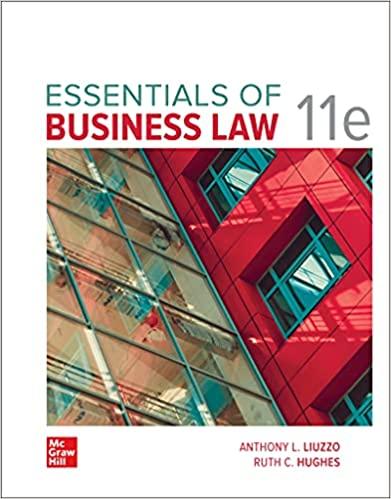Question
QUESTION 8 A trademark must go through a rigorous registration process before it will be recognized and receive any protection. True False QUESTION 9 A
QUESTION 8
A trademark must go through a rigorous registration process before it will be recognized and receive any protection.
True
False
QUESTION 9
A trademark can lose its right to protection if the trademarked name becomes so well known that it becomes a generic way of referring to a particular good or service.
True
False
QUESTION 10
Color, fragarance, shape, or sound can all be proper subjects of trademark protection under appropriate circumstances.
True
False
QUESTION 11
In order to recover for an action for trademark infringement, a plaintiff must provide proof that consumers have actually been confused by the use of the trademark.
True
False
QUESTION 12
"Senior rights," or the priority of ownership in a trademark, goes to the first person to file for federal trademark protection, not the first person to use the trademark in commerce.
True
False
QUESTION 13
Trademark law, unlike patent and copyright law, exists both at the federal and the state level.
True
False
QUESTION 14
Certain things are not entitled to patent protection, such as laws products of nature or laws of nature.
True
False
QUESTION 15
Protections against patent infringment are very broad and may even impose liability against a person who unknowlingly uses a patented process without the patent owners permission.
True
False
QUESTION 16
One of the most common forms of relief in a trademark infrigement lawsuit is an "injunction" in which the court orders that a party may not continue to use a trademark in a particular way.
True
False
QUESTION 17
"Senior rights" or trademark priority is given the the first to use the trademark, not the first to register it with the USPTO.
True
False
QUESTION 18
In patent law, "prior art" refers to the specific schematics and drawings submitted by a person at the beginning of the patent application which would allow another person to build the subject invention.
True
False
QUESTION 19
Types of patent protection include utility patents, design patents, and plant patents.
True
False
QUESTION 20
Select the answer which reflects a true statement:
Until March 2013, US Patent Law recognized the first to invent as having priority over the first person to file for patent protection; after March 2013, US Patent Law recognizes the first person to file for patent protection as the only person with a claim for patent protection.
Until March 2013, US Patent Law recognized the first person to file for patent protection as the only person with a claim for patent protection.; after March 2013, US Patent Law recognizes the first to invent as having priority over the first person to file for patent protection.
Patent protection may continue without any limitation of time so long as the patent holder renews the patent every 5 years.
The current duration of a patent is 15 years.
QUESTION 21
In order to be eligible for patent protection, an invention must be useful, novel, and non-obvious.
True
False
QUESTION 22
A person's right to protection in a new invention arises immediately upon invention, whether or not an application for patent protection is made.
True
False
QUESTION 23
In making a patent application, the applicant must specifically identify how the claimed invention is useful.
True
False
QUESTION 24
When considering whether an invention is "non-obvious," the USPTO will consider whether the claimed invention would have been obvious from the point of view of someone reasonably skilled in the art.
True
False
QUESTION 25
Select which of the following represents a true statement:
After the expiration of a utility patent, the owner of that patent still maintains significant rights to restrict the use of that invention without permission.
The "Doctrine of Equivalents" is a concept that refers to what occurs while two different parties are applying for the a patent at the same time.
The "Doctrine of Equivalents" is a concept used in patent infringement to impose patent infringement liability where the patent has not been literally infringed, but where the infringing invention accomplishes substantially the same function, in the same way, with the same result.
There is no doctrine of "contributory" or secondary patent infringement, only direct and literal patent infringement.
QUESTION 26
Match each of the terms or concepts with the term or description that best describes it.
The type of IP that would protect use of the Apple logo to identify the source of a commercial product.
The type of IP that would protect the creative work contained in the novel The Game of Thrones
Secondary meaning
The type of IP that would protect rights regarding the method and process of how an electric vehicle engine works
Prior Art
A.
Trademark
B.
A concept in trademark referring to whether a mark serves to uniquely identify a particular good or service through it use
C.
A concept in patent law refering to the already existing inventions and knowledge in a particular field
D.
Patent
E.
Copyright
Step by Step Solution
There are 3 Steps involved in it
Step: 1

Get Instant Access to Expert-Tailored Solutions
See step-by-step solutions with expert insights and AI powered tools for academic success
Step: 2

Step: 3

Ace Your Homework with AI
Get the answers you need in no time with our AI-driven, step-by-step assistance
Get Started


